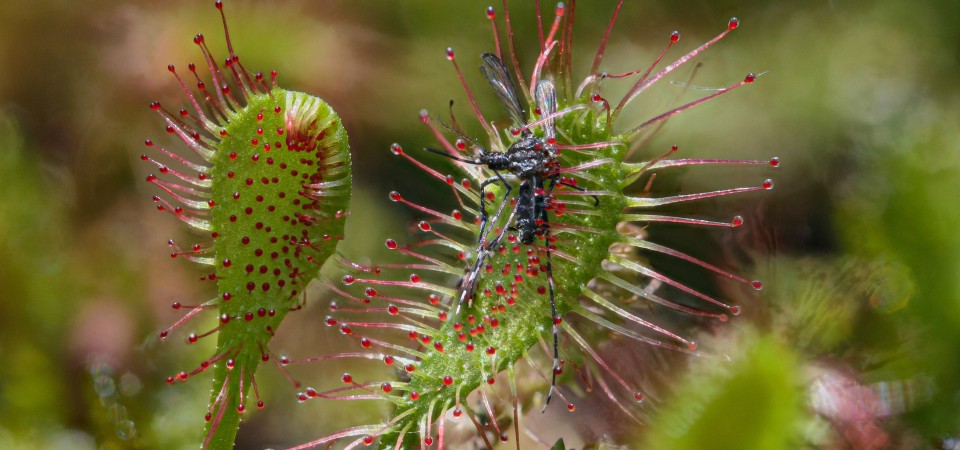Researchers from Loughborough and Gloucester universities found that they alter the density of their leaf tentacles and the uptake of nitrogen from prey to thrive in different microhabitats, such as mounds and hollows, within peatland ecosystems.
The study, published in the British Ecological Society journal, Functional Ecology, shows that plant carnivory plays a crucial role in enabling Drosera rotundifolia – its scientific name – to adapt to habitat heterogeneity at scales of less than one meter.
The findings support long-standing ecological models, including the cost-benefit model for plant carnivory.
This model predicts that plants invest more in carnivorous traits, such as prey capture, when nutrients from the soil are limited and light availability is high.
The study also highlights how climate influences nitrogen availability across different microhabitats.
Dr Jonathan Millet, of Loughborough Geography, said: “Sundews’ resilience to changing environmental conditions is an exciting breakthrough.
“By flexibly adapting to rainfall and sunlight, these plants persist in challenging habitats, providing crucial insights into species survival amid climate change.
“This study underscores the importance of microhabitat variability in shaping plant traits and offers broader implications for peatland ecosystems—key carbon sinks and biodiversity hotspots.
“As climate patterns shift, understanding how species like sundews adapt is essential for preserving ecological resilience in the face of global environmental change.”
Sites with higher inputs of water from rainfall, than losses through evaporation, such as in Scotland, displayed greater nitrogen accumulation in hollows, while sites with lower ratios, such as in Finland, exhibited more evenly distributed nitrogen between hummocks and hollows.
This variation in nutrient availability directly impacted how D. rotundifolia allocated resources to carnivory.
At the Scottish site, where hollows had more nitrogen available for plants and received more light, D. rotundifolia plants did not exhibit significant differences in prey capture or nitrogen uptake between hummocks and hollows.
In contrast, the Finnish site showed higher carnivorous investment in hollows, where light was abundant but root-derived nitrogen was scarce. In Sweden, with intermediate rainfall/evaporation levels, Sundew carnivory was in between the two extremes.
Key Findings:
- D. rotundifolia plants in unshaded, low-nutrient microhabitats exhibited greater investment in carnivorous traits, such as higher tentacle density and greater nitrogen uptake from prey.
- Precipitation: evapotranspiration P:ET) ratios influenced patterns of nitrogen accumulation, shaping microhabitat variability and driving phenotypic differences in plant carnivory.
- The ability of D. rotundifolia to adapt at such small spatial scales underscores the significance of microhabitat conditions in shaping plant traits and ecological strategies.
Dr Chris Hatcher, from University of Gloucestershire’s School of Education and Science, said: “The resilience and adaptability of sundews that we have discovered could be key to their survival in changing environmental conditions, which is a fantastic breakthrough for all admirers of this popular predatory plant.
“By exploring these adaptive patterns in rainfall and sunlight, we have demonstrated how carnivorous plants can persist in nutrient-poor environments by responding flexibly to local conditions.
“This adaptability might allow sundews to survive in specific microhabitats by eating more prey where it is most advantageous, which is an important discovery for understanding how species can survive in a changing environment.”
This study extends previous research by demonstrating that climate variability, which affects P:ET ratios and nutrient distribution, also influences plant phenotypic plasticity.
As climate change alters precipitation patterns and evapotranspiration rates, the ability of D. rotundifolia to adjust its carnivorous investment could play a critical role in maintaining its survival and ecological function within peatland habitats.
The research underscores the broader implications for peatland ecosystems, which serve as vital carbon sinks and biodiversity hotspots.
Understanding how key species like D. rotundifolia respond to environmental variability provides insight into the resilience of these ecosystems under future climate scenarios.
The study paves the way for further investigation into how hydrology and prey availability influence carnivorous plant traits. Researchers suggest that future work could focus on:
- Quantifying prey abundance across microhabitats to assess its role in shaping carnivorous investment.
- Exploring how genetic versus plastic responses drive phenotypic variability in D. rotundifolia and other carnivorous plants.
- Investigating how other species within peatland ecosystems respond to similar environmental drivers.
“By advancing our understanding of plant adaptation to microhabitat variability, this study offers valuable insights into the complex interplay between climate, nutrient distribution, and plant ecology,” said Dr Millet.
The research was led by the University of Gloucester and Loughborough University and involved fieldwork across three sites in Scotland, Finland, and Sweden.
ENDS
